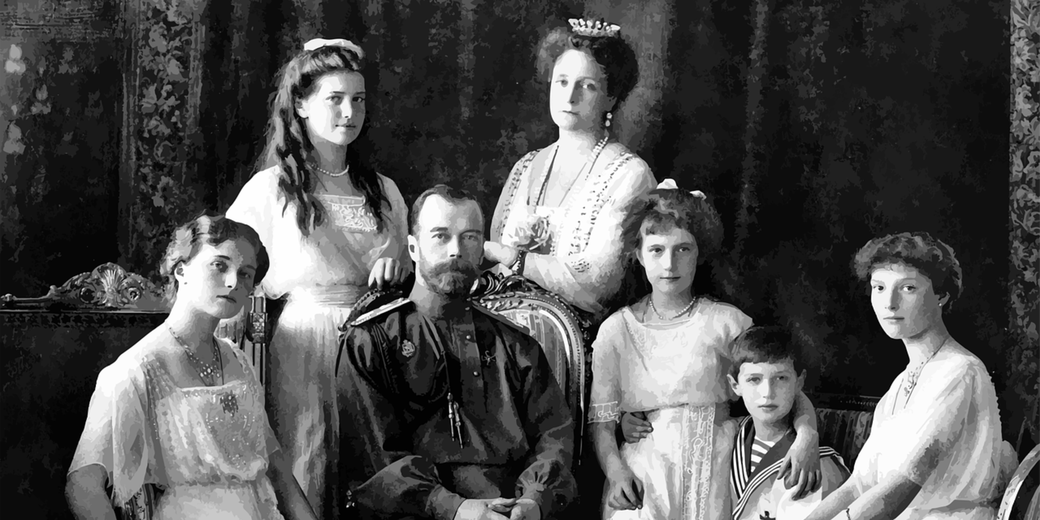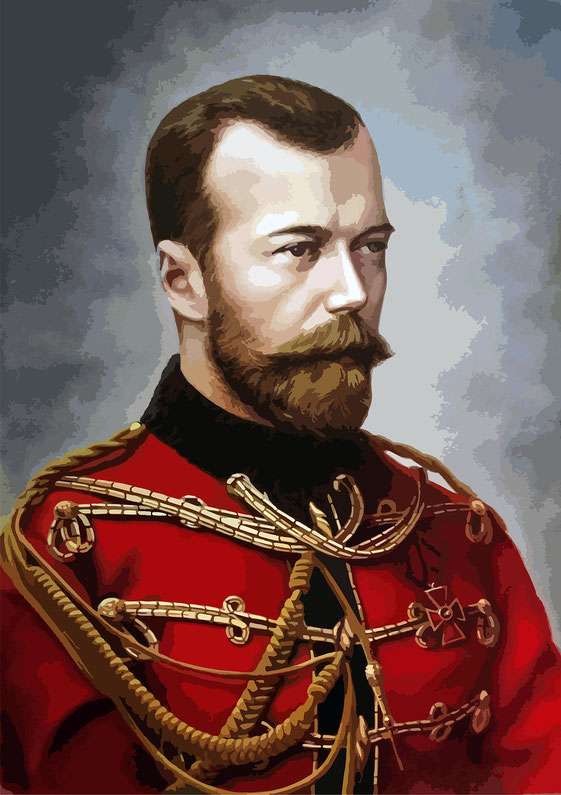The tragic end of Tsar Nicholas II and his family

In the early hours of 17 July 1918, Bolshevik guards executed Russia’s last tsar, Nicholas II, along with his wife Alexandra, their five children, and four loyal attendants, in the basement of a merchant’s house in Ekaterinburg.
The massacre occurred during the chaos of civil war and revolution, and the Soviet government kept the details hidden for decades.
Their deaths brought a violent conclusion to the 300-year Romanov dynasty and brought about the end of the Russian monarchy.
From Monarch to Captive
Nicholas II began his reign in 1894, following the death of his father, Alexander III, and ruled an empire that stretched from Poland to the Pacific Ocean.
He inherited an authoritarian government that allowed little public participation, and he remained personally committed to this system throughout his rule.
Discontent had already begun to build during the final years of his father’s reign, but it deepened during Nicholas’s time on the throne, due to economic inequality and national unrest that increased as the authorities violently suppressed reform movements.
The 1905 Revolution showed the growing weakness of the government and forced Nicholas to issue the October Manifesto, which promised civil liberties, such as the right to speak freely and the rights to assemble and associate, and established the Duma as a national assembly.
However, his refusal to grant the Duma real legislative power and his frequent use of emergency powers weakened confidence in the reform.
He retained complete control over the military and foreign affairs, and his conservative ministers reversed many of the promises made during the crisis.

After the start of the First World War in 1914, the situation rapidly worsened. By 1915, Nicholas had taken personal command of the army, which removed him from Petrograd and left the government in the hands of Empress Alexandra, whose influence over policy and personnel drew growing criticism.
Her reliance on a faith healer, Grigori Rasputin, who claimed to treat the haemophilia of their son Alexei, angered the public and hurt the monarchy’s standing.
Rasputin’s murder in December 1916 by a group of nobles, such as Prince Felix Yusupov and Grand Duke Dmitri Pavlovich, showed that many nobles no longer trusted the imperial court.
As military defeats increased and civilians suffered more, support for the monarchy fell in both towns and the countryside.
By February 1917, bread shortages and strikes combined with mutinies in Petrograd sparked mass demonstrations that overwhelmed the government.
As the army refused to suppress the protesters and key units joined the uprising, the Duma formed a Provisional Committee to take control.
On 15 March 1917, after pressure from both the military and civilian leaders, Nicholas abdicated in favour of his brother, Grand Duke Michael, who declined the crown and left the Russian throne vacant for the first time since the seventeenth century.
Following the abdication, the Provisional Government placed the imperial family under house arrest at the Alexander Palace in Tsarskoye Selo.
In August 1917, authorities moved them east to Tobolsk in Siberia in an attempt to protect them from unrest that was growing in the capital.
When the Bolsheviks seized power during the October Revolution, they saw the Romanovs as a potential rallying point for monarchist and anti-communist forces.
In April 1918, Bolshevik leaders transferred the family to Ekaterinburg and imprisoned them in the Ipatiev House, which the authorities renamed the "House of Special Purpose."
The building had previously belonged to Nikolai Ipatiev, a local engineer and former officer in the Imperial Army, before the Bolsheviks seized it.
The Execution
During the summer of 1918, anti-Bolshevik White forces pushed toward Ekaterinburg as part of their campaign to retake the Ural region from Red control.
The local Soviet leadership feared that the Romanovs might be liberated and used as a political weapon against the Bolsheviks.
Under these circumstances, the Ural Regional Soviet approved the execution of the former tsar and his family.
Yakov Yurovsky, the local head of the Cheka and commander of the house, received instructions to carry out the operation.
The decision has often been attributed to Yakov Sverdlov, a prominent Bolshevik in Moscow, although no definitive order has been found.
On the night of 16 July, Yurovsky told the family and their attendants that they would be moved due to threats of violence in the city.
At around 2:00 a.m., he and several guards led them to the basement on the excuse that a transport vehicle awaited them.
Nicholas carried Alexei, who could not walk due to his illness, and the others followed in silence.
Once everyone was inside, Yurovsky read a brief statement announcing the decision of the Ural Soviet to execute the tsar.
Without further warning, Yurovsky drew his revolver and shot Nicholas in the chest.
The other guards immediately opened fire, but the room quickly filled with smoke and confusion, and the execution became chaotic.
Bullets failed to kill several of the daughters because they had sewn over three pounds of diamonds and other gemstones into their corsets, which acted as makeshift protection.
The executioners then used bayonets and additional gunshots to finish the task.
Within minutes, the entire family and their four loyal servants, Dr. Eugene Botkin, maid Anna Demidova, footman Alexei Trupp, and cook Ivan Kharitonov, were dead.
The Bolsheviks loaded the bodies onto a truck and drove them into the nearby forest outside Ekaterinburg.
After a failed attempt to dispose of the corpses in a mineshaft at Ganina Yama, Yurovsky ordered his men to relocate the bodies to another site.
They burned some of the corpses, poured sulphuric acid over the bodies to destroy facial features, and then buried them in shallow pits.
Yurovsky later altered the burial site to hide its location. The mass grave was located at Pig's Meadow (Porosyenkov Log), several kilometres from the original site.
The Soviet government kept the killings secret. For years the government only admitted to Nicholas’s death and claimed that his family was safe.
Aftermath and Legacy
Following the execution, monarchist groups and foreign observers asked for information about the fate of the Romanovs, but the Bolsheviks issued only vague statements.
Their refusal to disclose the truth helped create rumours that some of the children had survived.
Several women who claimed to be Anastasia or Maria appeared in the 1920s and the 1930s.
The most well-known of these was Anna Anderson, who lived in Germany and the United States and convinced many that she was Anastasia.
Her claim remained controversial until DNA evidence disproved her identity in the 1990s.
In July 1991, Soviet authorities, now under the Russian Federation, finally allowed the exhumation of a mass grave discovered near Ekaterinburg.
Forensic teams, including Russian pathologist Sergey Nikitin and U.S. DNA expert Peter Gill, identified the bodies of Nicholas, Alexandra, and three of their daughters through dental records and genetic analysis.
A second grave found in 2007 contained the bodies of Alexei and the fourth daughter, which confirmed that all members of the imperial family had died on the same night in 1918.
These findings brought a close to decades of speculation and confirmed the brutality of the execution.
In 2000, the Russian Orthodox Church canonised the Romanovs as 'passion bearers', a title reserved for those who died with Christian humility.
The Church on the Blood, built over the site of the Ipatiev House, has become a place of pilgrimage.
Since 2005, thousands of Russians have taken part in the Royal Days (Tsarskiye Dni), a 21-kilometre memorial march from the church to the site of the original graves each July.
Debates over Nicholas II’s reputation continued into the twenty-first century, with some Russians honouring him as a martyr and a symbol of the old order destroyed by the revolution, while others see his actions as contributing directly to the downfall of the monarchy.
His failure to enact meaningful reform, his blind loyalty to advisers like Rasputin, and his mismanagement of the war effort were points of historical criticism.
Yet the tragedy of his family’s fate and the secrecy surrounding their deaths have made the Romanovs a powerful symbol of a world that had ended.
What do you need help with?
Download ready-to-use digital learning resources
Copyright © History Skills 2014-2025.
Contact via email
With the exception of links to external sites, some historical sources and extracts from specific publications, all content on this website is copyrighted by History Skills. This content may not be copied, republished or redistributed without written permission from the website creator. Please use the Contact page to obtain relevant permission.





